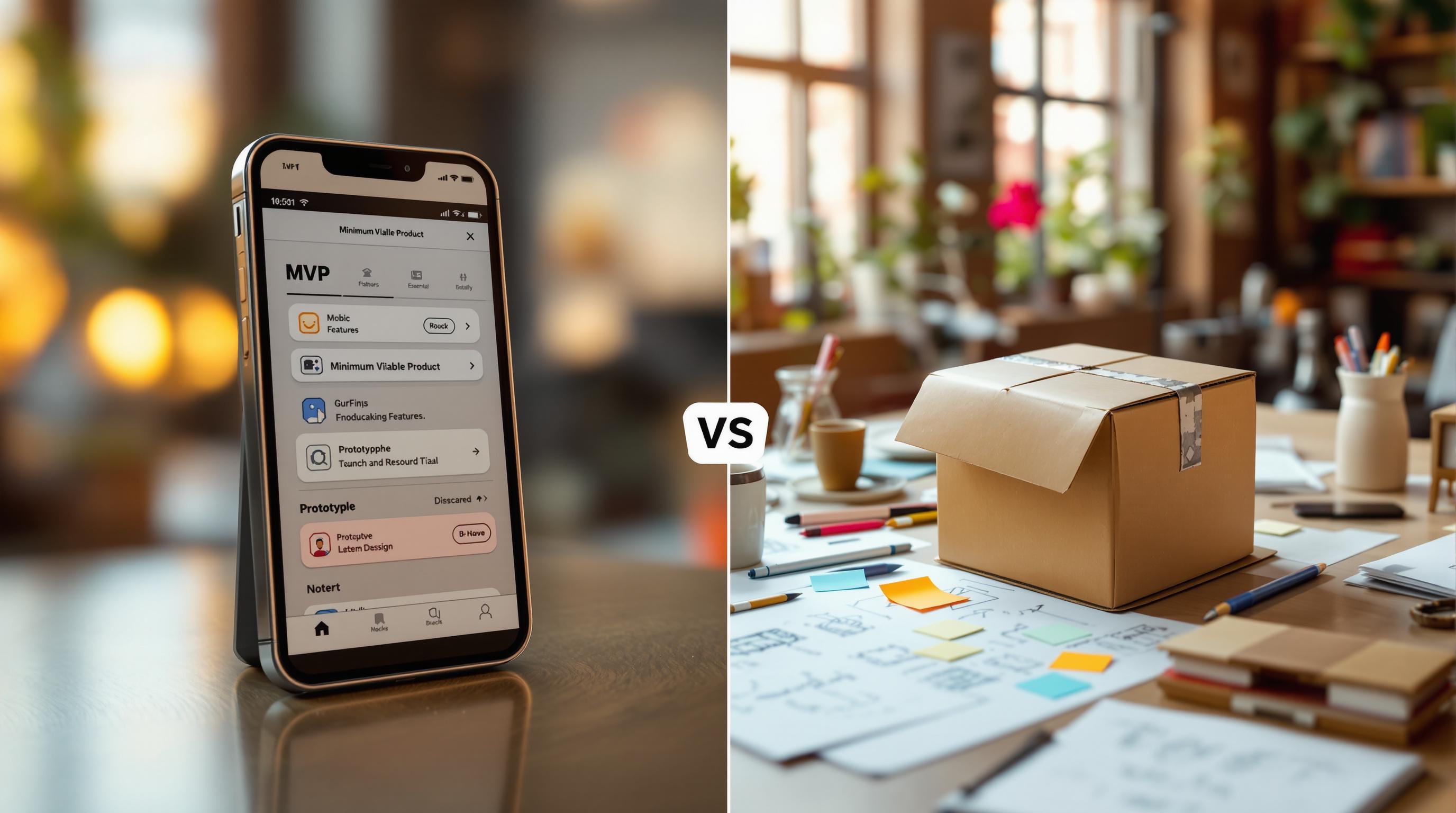Go/No-Go: A Fast Framework for Deciding Which Features Make Your BIM MVP
Taher Pardawala June 27, 2025
When building a BIM MVP, deciding which features to include can make or break your project. Overloading your MVP with unnecessary features leads to wasted resources, delays, and a product that fails to meet user needs. Instead, focus on creating a lean, functional product that solves core problems. Here’s how:
- Use prioritization frameworks: The Impact vs. Effort Matrix helps identify high-value, low-effort features, while the MoSCoW Method categorizes features into Must-have, Should-have, Could-have, and Won’t-have. These tools ensure you focus on what truly matters.
- Align stakeholders: Misaligned priorities lead to conflicts and scope creep. Use structured feedback methods like surveys, interviews, and analytics to gather input and set clear priorities.
- Stick to deadlines: Set firm feature freeze dates to avoid last-minute changes, which often increase defects and delay releases. Capture additional feature ideas in a Phase 2 backlog for future iterations.
- Test early: Validate feature choices with rapid prototypes to ensure they address user needs before committing to full development.
Key features to prioritize for a BIM MVP:
- 3D Modeling and Visualization – Simplify design processes and reduce costs.
- Clash Detection – Prevent costly errors during the design phase.
- Team Collaboration Tools – Improve communication and tracking.
- Mobile-First Design – Ensure usability on construction sites.
How To Plan Your MVP (Minimum Viable Product) in 5 Simple Steps
2 Frameworks for Ranking BIM MVP Features
Sorting through a long list of potential features for your BIM MVP can feel overwhelming. With dozens of options, it’s easy to hit decision paralysis. Thankfully, two reliable frameworks can help you prioritize features and make informed, data-driven decisions about what to include in your initial release.
Impact vs Effort Scoring
The Impact vs Effort Matrix is a simple yet powerful tool that helps you evaluate features by answering two key questions: How much value will this feature bring to the business? and How much effort will it take to implement? Start by listing out each feature and assigning it an impact and effort score on a scale of 1 to 10.
- Impact could include factors like user adoption potential, revenue growth, or competitive differentiation.
- Effort covers things like development time, technical complexity, and resource demands.
Once you’ve scored each feature, plot them on a four-quadrant matrix. Here’s what the matrix reveals:
- High-impact, low-effort features: These are your "wins" – features that deliver maximum value with minimal investment.
- High-impact, high-effort features: These are "major projects" that may be better suited for later releases.
- Low-impact, low-effort features: Known as "fill-ins", these can be tackled if there’s extra bandwidth.
- Low-impact, high-effort features: These are "money pits" that should be avoided.
For example, a "win" for a BIM MVP might be a basic 3D model viewer. It’s simple to build and provides significant user value. To make this evaluation even more precise, consider using metrics like potential monthly recurring revenue, the number of users affected, or time saved per session. Designli has highlighted this framework as particularly helpful for prioritizing features, addressing bugs, and planning product roadmaps [1].
While this framework is great for quick evaluations, the MoSCoW method offers a more structured approach to managing feature priorities.
MoSCoW Method for Startup Founders
The MoSCoW method is another effective way to prioritize features, especially when you need to align multiple stakeholders. It organizes features into four clear categories: Must have, Should have, Could have, and Won’t have. Here’s how each category works:
- Must-have: These are essential features without which the MVP can’t function. For example, file uploads or user authentication.
- Should-have: These add significant value but aren’t critical for the MVP’s usability. Think collaboration tools or advanced search options.
- Could-have: Nice-to-have features that can be included if time and budget allow, such as customizable dashboards or integrations with other platforms.
- Won’t-have: Features explicitly excluded from the current release. This helps set boundaries and prevents scope creep.
Companies like Dropbox and Spotify have successfully used the MoSCoW method to stay focused on core features and avoid overloading their MVPs with unnecessary extras [2].
Both frameworks offer clear benefits. The Impact vs Effort Matrix is particularly helpful when you’re working with limited resources and need to identify quick wins. On the other hand, the MoSCoW method is ideal for managing stakeholder expectations and keeping your project scope under control.
The key is to pick the framework that aligns with your current needs and use it to build a BIM MVP that’s both focused and ready to scale.
Getting All Stakeholders to Agree on BIM MVP Priorities
Building a successful BIM MVP requires getting all stakeholders on the same page. When founders, developers, architects, engineers, and end users prioritize different features, conflicts are almost guaranteed. Tools like Impact vs. Effort and MoSCoW frameworks can help rank features, but refining these priorities depends on aligning everyone’s input. Miscommunication is a major culprit, contributing to 56% of project failures [7]. That’s why stakeholder alignment is essential to keep your BIM MVP on track.
Structured processes help turn diverse opinions into actionable decisions. Without alignment, you risk scope creep, budget overruns, and disengaged teams. A unified approach ensures you gather clear, actionable feedback from everyone involved.
How to Collect and Use Stakeholder Feedback
Different stakeholders need different ways to share their input. While developers might prefer technical surveys, hands-on workshops often work better for end users. Gathering stakeholder feedback is vital – it improves planning, strengthens collaboration, spots problems early, encourages fresh ideas, and builds trust [3].
To get a full picture, combine multiple methods:
- Surveys and Questionnaires: These are great for larger groups, helping you track changes over time and measure satisfaction. Keep them short, include optional comment sections for deeper insights, and offer anonymity to encourage honest responses.
- Interviews and Focus Groups: For key stakeholders like project managers or lead architects, these methods provide detailed insights. Create a welcoming environment, explain the purpose, and end with an open-ended question like, “What feature concerns keep you up at night?”
- Digital Platforms and Tools: Analytics can track how stakeholders interact with current systems. Use these tools to monitor feature usage and identify pain points that surveys might miss.
| Method | Best Suited For | Success Tips |
|---|---|---|
| Surveys and Questionnaires | Engaging large groups, tracking trends, collecting satisfaction ratings | Keep it brief, offer anonymity, plan analysis ahead, include comment fields for extra input |
| Interviews and Focus Groups | Capturing detailed feedback from key stakeholders | Explain goals, create a safe space, record sessions, and use open-ended questions |
| Digital Platforms and Tools | Tracking interactions, mapping journeys, and identifying user difficulties | Use analytics tools, set up automated reporting, and monitor feature usage |
Once the feedback is in, prioritize features based on their value, complexity, and alignment with your audience’s needs. Don’t just tally votes – give more weight to feedback from experts or stakeholders whose needs closely match your target market. This approach ensures decisions are guided by meaningful insights, reducing conflicts and keeping teams aligned.
Keeping Decisions Clear and Avoiding Team Conflicts
Conflicts in multi-stakeholder projects are inevitable, whether they stem from task-related issues, differing values, or strained relationships [4]. What separates successful BIM MVPs from failed ones is how effectively these disagreements are managed.
Documenting decisions is key. Clearly explain why certain features were chosen and others weren’t. Share the criteria used, the data behind your choices, and how stakeholder feedback shaped the outcomes. This transparency helps prevent recurring disputes.
When conflicts arise, address them immediately. Bring the involved parties together to explore solutions collaboratively. As Jennifer Herrity advises:
"You need both parties to agree on what the issue is and discuss needs that aren’t being met on both sides. Obtain as much information as possible on each side’s outlook. Continue asking questions until you are confident that all the conflicting parties understand the issue." – Jennifer Herrity [5]
Regular demo sessions and OKR syncs allow teams to review progress and adjust priorities as needed. Include key players – architects, engineers, contractors, and developers – to ensure everyone stays informed and surprises are minimized. These sessions also let stakeholders see how their input is being implemented.
Centralized dashboards can further streamline coordination, offering real-time visibility into feature development. They help track and resolve issues before they escalate.
Focus on shared goals rather than personal preferences. As Kimberly Osborne puts it:
"Communications leaders can remind both internal and external stakeholders what the common goal is to redirect frustrations into a harmonious resolution." – Kimberly Osborne [6]
A BIM Execution Plan (BEP) can also prevent miscommunication. This plan should outline roles, schedules, and data-sharing workflows, along with agreed-upon procedures like file naming conventions and software requirements. Regular updates to this documentation ensure it stays accurate and reflects evolving needs. With scope creep affecting 52% of BIM projects and adding 10–20% to budgets [7], clear documentation is crucial for identifying requests that fall outside the original scope.
When stakeholders feel their voices are heard and understand how decisions are made, they’re more likely to support the final MVP – even if their preferred features don’t make the initial cut.
sbb-itb-51b9a02
Setting Feature Freeze Dates and Testing Your BIM MVP
Once you’ve aligned your priorities, it’s time to lock down your timeline. Why? To avoid scope creep, which is a major culprit behind missed deadlines. A 2024 Gartner survey found that 76% of product launches fail to meet their original timelines, with feature creep being the main reason in 63% of those cases. Even worse, products delayed by just three months can lose up to 33% of their lifetime profit potential [9]. This makes setting firm feature freeze dates and testing your feature choices early on essential for the success of your BIM MVP.
How to Set and Stick to Feature Freeze Dates
After prioritizing features, the next step is to finalize your feature list and timeline. A feature freeze is essentially a pause on adding new features, typically just before a product’s release [10]. During this period, the focus shifts to stabilizing current features, fixing bugs, and ensuring the product’s overall quality. The key to making this work is sticking to a non-negotiable deadline.
Start by creating a Product Requirements Document (PRD). This document clearly defines the boundaries of your MVP and acts as a reference when stakeholders start requesting additional features. Once the scope is locked, new features should only be added if they address critical fixes or improvements [8].
To make the freeze official, announce it during sprint planning so everyone is on the same page. Update your product backlog to reflect freeze priorities, and use daily stand-ups to focus solely on stabilization tasks, not new feature development [10]. This approach helps safeguard both product quality and team morale. Research shows that last-minute feature changes – those made within two weeks of release – can increase critical defect rates by 4.2× and lower team satisfaction by 72% [9].
What about those extra feature requests that inevitably come up? Instead of derailing your timeline, create a "Phase 2 Backlog" to capture these ideas for future iterations [8]. If you’re working in Kanban, you can tighten your definition-of-done criteria, adjust work-in-progress limits, and even set up a dedicated swim lane specifically for freeze-related activities [10].
A great example of feature freeze discipline is Slack. Originally designed as an internal tool for a gaming company, Slack focused on core features like team messaging, file sharing, and searchable conversation history. By testing early versions with users, the team avoided unnecessary features and concentrated on solving the core problem [8].
Once your freeze dates are locked in, the next step is to validate your prioritized features before diving into full-scale development.
Testing Feature Choices with Quick Prototypes
Before committing significant resources to development, it’s smart to confirm your feature priorities through rapid prototyping. This method allows you to test your ideas quickly and gather feedback with minimal effort. Low-fidelity prototypes – like wireframes, mockups, or even simple paper sketches – are perfect for this stage [11].
As Will Breen puts it:
"Rapid prototyping is not about creating a fully-fledged product or a complete set of design screens. Instead, it’s about developing a straightforward, design-based prototype that allows me to test assumptions and gather valuable user insights." [14]
Testing with a small group of 5–7 participants can uncover up to 85% of major usability issues [12]. The key is to recruit actual users from your target audience – whether they’re architects, engineers, or project managers – to ensure your BIM tool aligns with their real-world needs.
Take inspiration from Dropbox, which used a simple video prototype to showcase its software’s functionality. This approach not only validated the concept but also generated significant interest [14]. Similarly, Airbnb tested its idea with a bare-bones website that highlighted air mattress rentals in apartments, effectively gauging user demand [13].
For BIM MVPs, consider creating interactive mockups that demonstrate navigation between 3D models and project data or simulate workflows for sharing design changes. These prototypes can help test core interactions before diving into complex development. Gather feedback from users and iterate based on what you learn, using tools like an impact/urgency matrix to prioritize improvements [11][12]. Keep in mind that response rates vary depending on your feedback methods. While in-app surveys typically achieve 15–25%, user interviews can reach as high as 45–60% [12].
Must-Have Features for Your BIM MVP
Once you’ve identified priorities and gathered feedback from stakeholders, it’s time to focus on the features that truly matter. Your goal should be to address actual user problems without stretching your resources too thin. Research reveals that 80% of product features are rarely or never used because they don’t solve meaningful user challenges[16]. For BIM startups, this makes choosing the right features absolutely critical.
Core BIM MVP Features You Can’t Ignore
To make an impact, your BIM MVP should focus on 3–5 core features that directly tackle your users’ biggest pain points[18]. Based on industry trends and user feedback, here are the key features to prioritize:
3D Modeling and Visualization is the backbone of any BIM tool. This feature allows teams to create detailed 3D models and simulate spaces, helping them finalize designs and spot potential issues before construction begins. As one expert puts it:
"BIM’s 3D models and space simulations let teams finalize designs and spot clashes before breaking ground"[15].
This capability alone can reduce project costs by up to 20%[15]. Instead of trying to replicate the full functionality of advanced BIM tools, focus on delivering essential modeling features that validate design concepts without overwhelming users.
Clash Detection is another must-have. This feature identifies conflicts between different building systems during the design phase, saving users from costly rework down the line. With nearly 50% of contractors reporting challenges like tool loss and project delays[16], clash detection addresses a critical pain point.
Team Collaboration Tools are essential for keeping all stakeholders on the same page. A centralized BIM platform should enable real-time communication, allowing team members to comment on models, share updates, and track changes easily. This reduces miscommunication and minimizes the risk of change orders[15].
Mobile-First Design ensures your BIM MVP works seamlessly on construction sites, where conditions can be challenging. Whether it’s bright sunlight, one-handed operation, or spotty internet connectivity, your platform needs to perform reliably in the field[16].
Additionally, these operational features are key:
- Offline Capability: On-site data entry must be uninterrupted, with automatic syncing once connectivity is restored[16].
- Quick Data Entry: Simplified workflows for entering data are critical, especially for teams managing multiple projects. Reducing clicks and typing can make a big difference, particularly when 29% of startups fail due to cash shortages before achieving product-market fit[17].
Prioritizing Features with the MoSCoW Method
To stay focused, consider using the MoSCoW method to prioritize features. Here’s how it might look for a BIM MVP:
| Feature Category | MVP Priority | Rationale |
|---|---|---|
| 3D Modeling (Basic) | Must-Have | Core functionality defining your BIM offering |
| Clash Detection | Must-Have | Directly addresses critical user pain points |
| Mobile-First Design | Must-Have | Ensures usability on job sites |
| Real-Time Collaboration | Must-Have | Keeps teams aligned and informed |
This structured approach helps ensure you focus on what matters most. Startups using the MoSCoW method are 35% more likely to achieve product-market fit in their first year[19]. Additionally, 87% of successful SaaS companies leverage third-party tools during the MVP phase[19]. Instead of trying to build everything from scratch, concentrate on validating the core features that set your product apart.
As Eric Ries famously said:
"An MVP is a new product iteration that enables the team to amass the most concrete consumer data with the least amount of work"[16].
Conclusion: Building a Focused BIM MVP That Works
Creating a successful BIM MVP hinges on a few key elements: clear frameworks, aligned stakeholders, and disciplined deadlines. When BIM strategies are well-coordinated, projects can see up to 30% faster delivery times and a 20% reduction in rework – a game changer in an industry where efficiency is everything[7].
Tools like Impact vs Effort and MoSCoW help zero in on core features, but the real magic lies in team alignment. Take the example of a leading U.S. construction firm: through weekly demos, OKR syncs, and structured alignment practices, they slashed project delays by 25% and improved client satisfaction by 15%. These rituals also combat scope creep, a common challenge affecting 52% of projects, which can inflate budgets by 10–20%[7].
Another crucial practice is setting feature freeze dates. These deadlines act as guardrails, preventing endless revisions and shifting priorities. By defining what gets built – and when – you create the stability needed to deliver a functional product. As Brian Sauer, Principal, explains:
"Using BIM via Revit means everything can be viewed in real time, as opposed to waiting for weekly meetings or updates from the architect or engineer"[7].
This kind of real-time visibility is invaluable in fast-paced development cycles.
At AlterSquare, our I.D.E.A.L Delivery Framework leverages these principles to build scalable BIM MVPs in just 90 days. By prioritizing stakeholder alignment, clear frameworks, and firm deadlines, we ensure your BIM MVP stays on track and delivers results.
The data speaks for itself: 61% of contractors using BIM report better outcomes when alignment practices are in place[7]. Keep your focus on the core features, secure early buy-in from stakeholders, and stick to disciplined timelines to create a BIM MVP that truly works.
FAQs
How can I use the Impact vs. Effort Matrix and the MoSCoW Method to prioritize features for my BIM MVP?
The Impact vs. Effort Matrix is a straightforward tool for evaluating features by sorting them into four quadrants: quick wins (high impact, low effort) and big bets (high impact, high effort) are key examples. This approach helps you zero in on features that bring the most value with the least amount of effort.
The MoSCoW Method adds another layer by organizing features into four groups: Must-Have, Should-Have, Could-Have, and Won’t-Have. This method ensures that the most essential features are prioritized for your MVP, while also managing expectations about what will and won’t be included.
To use both methods together, start by scoring each feature for impact and effort to pinpoint quick wins. Then, apply the MoSCoW categories to prioritize those high-impact, low-effort features as Must-Have or Should-Have. This combined approach helps your MVP deliver strong value while remaining practical and aligned with stakeholder objectives.
How can I align stakeholders when selecting features for a BIM MVP?
When planning the features of a BIM MVP, it’s crucial to bring all stakeholders into the conversation as early as possible. Start by identifying who the key players are, understanding their roles, and mapping out their priorities and expectations. Clear and open communication is a must – lay out a plan to keep everyone informed and actively engaged throughout the process.
Leverage BIM as a central platform for real-time data sharing and visualization. This not only simplifies collaboration but also helps everyone stay aligned when deciding which features to prioritize. By reducing misunderstandings and ensuring clarity, the team can work more cohesively. Above all, focus on building trust and being transparent – this helps resolve potential conflicts and keeps everyone working toward the same goals.
How does rapid prototyping help prioritize features for a BIM MVP?
Rapid prototyping is a game-changer for teams working on a BIM MVP. By creating functional mock-ups or simplified versions of the product, teams can quickly test ideas, refine features, and figure out what truly adds value – all while keeping effort to a minimum. This approach not only saves time but also cuts down on unnecessary resource use.
Having a tangible model in hand makes communication among stakeholders much smoother. Everyone can see and understand the proposed features, which encourages early feedback and reduces the chances of expensive revisions later in the process. In short, prototyping enables smarter decisions, speeds up development, and clears the way for delivering an MVP that makes a real impact.








Leave a Reply